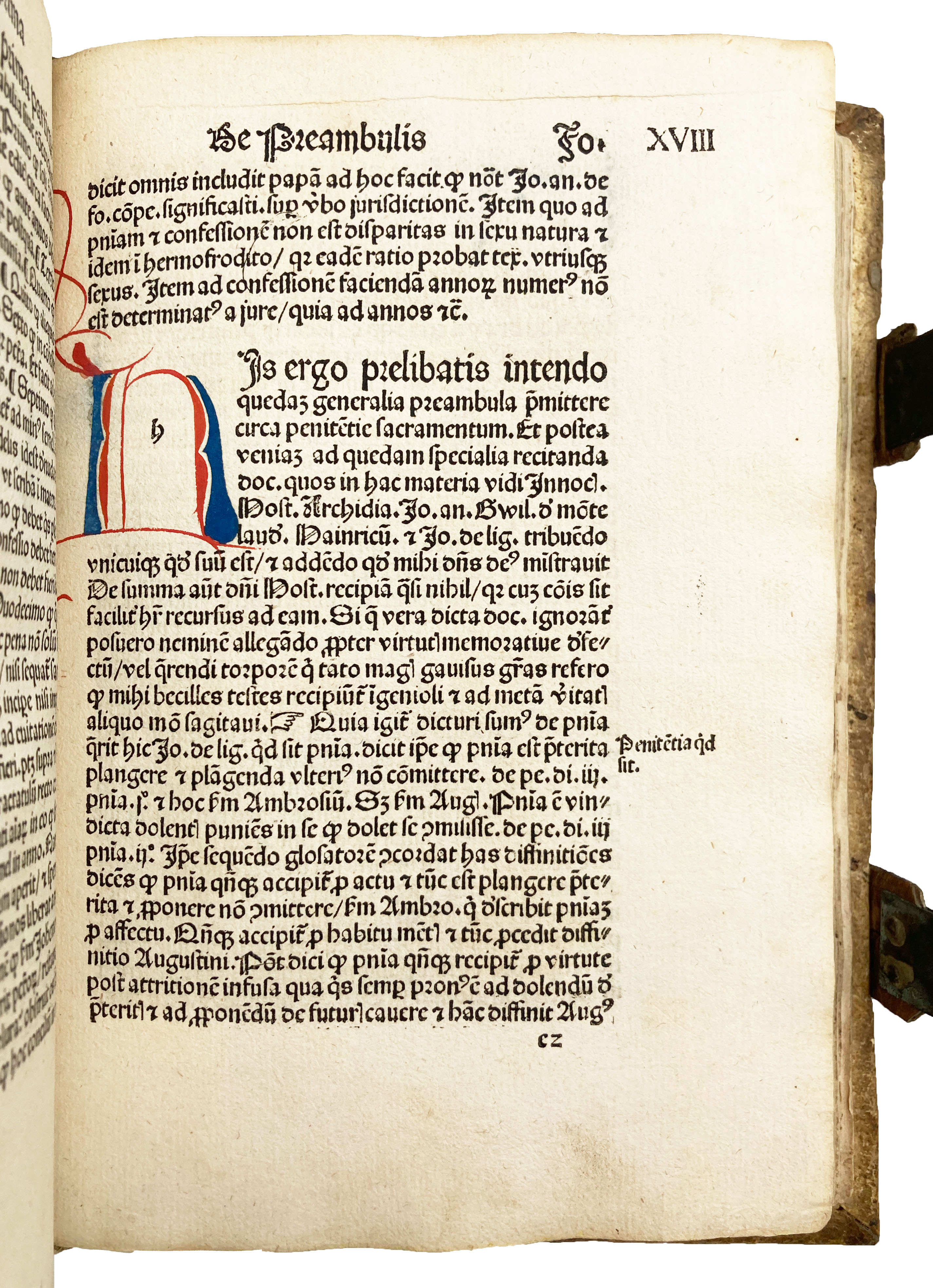ODENDORFF, Henricus de.
HANDSOME CANON LAW
Repetitio capituli ‘Omnis utriusque sexus’
Memmingen, Albrecht Kunne, 1490.£15,000.00
FIRST EDITION. 4to, pp. (xvi) 116. Gothic letter, charming blue and red rubricated initials throughout, one woodcut initial. Rare minor marginal stains or marks, light waterstain to lower blank margin of a few final gatherings, tiny wormhole to lower outer corner of last two ll, mainly marginal red ink splash to one fol. (not affecting reading). A very good, crisp and clean, well-margined copy in contemporary pigskin, covers double blind ruled to a panel design, upper cover with two borders, roll of foliage to second, flower stamps to corners and in central panel, lower cover featuring a single outer border and a similar decoration with the same floral stamps, spine with blind ruled raised bands. Attractively decorated brass clasps. Two printed pages of “Regulae grammaticales antiquorum” (Leipzig, Conrad Kachelofen, about 1490-1495) used as pastedowns, stubs from a C15 manuscript psalter with red initials. C20 bookplate “APR” to front pastedown.
Attractive first edition of this encyclopedia of canon law. This incunable was beautifully produced by Albrecht Kunne (b. 1435), the earliest printer of the Upper Swabia region in Germany. Kunne was an expert on printing types – he designed and created the lead letters himself – and this is the first appearance of his own ‘Schwabacher’, a vibrant and decorative gothic type that resembles handwriting. Remarkably, this volume also contains one of the earliest examples of printed manicules. These fine ‘little hands’ (maniculae), originally used in manuscripts to draw attention to important points in text, were introduced in print by Leonhard Pachel and Ulrich Scinzenzeller in 1479. Kunne was among the first to adopt and reproduce this symbol. The volume is further embellished with calligraphic hand-painted initials in blue and red ink.
Henricus de Odendorff (often spelled Oldendorp/Odendorp, c. 1360-1400), was born in Cologne. A ‘licentiatus utriusque iuris’ meaning he obtained a doctorate in both civil and church law, he became rector at the University of Vienna in 1385 and contributed to the drafting of its statutes. He died, probably from the plague, around 1399-1400. ‘Repetitio capituli’, is an encyclopaedia on confession comprising a detailed explanatory commentary on Canon 21, ‘Omnis utriusque sexus’ (Everyone of both sexes), issued by the IV Lateran Council in 1215. This commands all Christians above twelve years of age, male or female, lay or clerical, to confess all sins at least once a year to their parish priest, under penalty of excommunication. In the introduction, Odendorff expresses his hope that this work will be appreciated and read in schools. This treatise explains every aspects of the sacrament of confession and what is expected from confessors as well as the rules they must obey. After the text of the canon in Latin and a German vernacular translation by Sixtus (von Tannberg), bishop of Freising (d. 1495), Odendorff analyses the text of the canon word by word (underlined in red), focusing on one ‘particula’ (small section) at a time. The six main chapters deal with the three parts of confession – contrition, confession, satisfaction – and communion, and explain that a confessor should be ‘peritus’ (expert), discuss different forms of penance (including how many days a man should ‘abstain from his woman’), and innumerable rules relating to particular circumstances e.g. confession in shipwreck or particular people e.g. the confessor of a prince.
In 1577, this book was gifted to “M. Christophorus Kirmeserus”, most likely Magister Christoph Kirmeser (b. 1550), a remarkable scholar born in Schemnitz (Upper Hungary) who graduated at Ingolstadt. He was rector of the pastoral school of Nysa (Poland, 1574-80) and later abbot of the Augustinian Monastery of Glatz (Poland, 1583) and of the Benedictine monastery of St. Lambrecht (Austria, 1596). He wrote a book of sermons published in 1582 at Ingolstadt. The donor of this volume was ‘Johannes Teskl”, who defines himself as a ‘Doctor’ meaning that he obtained a doctoral degree. The name might correspond to the German ‘Johann Teschl’ or ‘Teschel’ – a man named Johann Teschel was priest of Marienau (Germany, south of Leipzig) in 1598 (K. Stehr, Chronik der ehemaligen Hochritterlichen Maltheser-Ordens-Commende, 1845, p. 179).
USTC 747567; ISTC io00023000; GW 12255; Goff O23. A. Kastner, Aus der Geschichte der Neisser Pfarrgymnasiums, p.13.In stock








